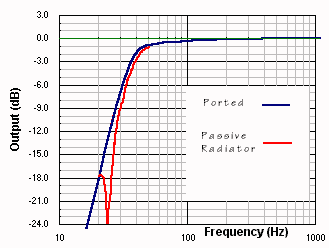Tell me about passive radiators, pro and con
Options
methenyiac
Posts: 5
I was enjoying my Polk RTA 12 speakers tonight and I began wondering what technical facts and fancy there are to know about its passive radiator woofers. Normally my attention is captured by their tweeters' wonderful performance, but tonight I noticed how well the bottom cabinet was doing its job. No, it didn't go as low or as loud as the KEF 104.2s standing next to them, but the difference wasn't extreme, by my senses.
All this bass from a passive drumhead that magnifies the bass from a pair of six-inchers? If this is such an effective idea,why don't more speaker manufacturers use it? Size, I'd guess. There are some of the largest woofers I see in high-end audio, outside subwoofers.
I'm new to the Polk world, and not that grounded in the engineering. But if someone wants to expound on this, I'm all eyes... the Polks have my ears.
All this bass from a passive drumhead that magnifies the bass from a pair of six-inchers? If this is such an effective idea,why don't more speaker manufacturers use it? Size, I'd guess. There are some of the largest woofers I see in high-end audio, outside subwoofers.
I'm new to the Polk world, and not that grounded in the engineering. But if someone wants to expound on this, I'm all eyes... the Polks have my ears.
So little time, so many speakers!
Post edited by methenyiac on
Comments
-
You still see some high-end speakers (and subwoofers) using passive radiators, but high-end is the key.
Why? Most manufacturers in todays market view a passive radiator as an 'expensive port'. We all know cost $ rule, in todays mass-market audio world. I personally, think they offer a 'best of both worlds' scenario, between Acoustic Suspension, and Ported enclosures.
PR's (usually) offer a nice, articulate bass, with a very gradual roll off below the resonant frequency, as acoustic suspension designs do (around 6db/octave), but still remain 'easier' to drive, without having to power big active woofers, with large motor structures.
The biggest drawback to AS enclosures is usually efficiency - they typically require more power, and aren't as easy to drive. On the flip side, ported enclosures, while sometimes digging just a tad lower, can tend to be a little less accurate and harder to place (boominess), and the roll off at the resonant freq is like a waterfall - somewhere on the order of 18-24/db octave.
In a nutshell, I believe PR's offer good, tight and articulate bass, yet remain more efficient, easier to drive, and are much less picky with placement in any given room.
Cheers,
Russ
PS, welcome to our humble audio abode.Check your lips at the door woman. Shake your hips like battleships. Yeah, all the white girls trip when I sing at Sunday service. -
Nice post, Russ. I really lke the sound of the PR's at my disposal.
Two Channel Setup:
Speakers: Wharfedale Opus 2-3
Integrated Amp: Krell S-300i
DAC: Arcam irDac
Source: iMac
Remote Control: iPad Mini
3.2 Home Theater Setup:
Fronts: Klipsch RP-160M
Center: Klipsch RP-160M
Subwoofer: SVS PB12NSD (X 2)
AVR: Yamaha Aventage RX-A2030
Blu Ray: Sony BDP-S790
TV Source: DirecTV Genie -
All true, but when there is no shortage of amp power and you're driving big acoustic suspension jobs, to my taste nothing compares.
George Grand (of the Jersey Grands) -
Except for open / infinate baffle, right?Check your lips at the door woman. Shake your hips like battleships. Yeah, all the white girls trip when I sing at Sunday service.
-
Originally posted by RuSsMaN
PR's (usually) offer a nice, articulate bass, with a very gradual roll off below the resonant frequency, as acoustic suspension designs do (around 6db/octave), but still remain 'easier' to drive, without having to power big active woofers, with large motor structures.
The biggest drawback to AS enclosures is usually efficiency - they typically require more power, and aren't as easy to drive. On the flip side, ported enclosures, while sometimes digging just a tad lower, can tend to be a little less accurate and harder to place (boominess), and the roll off at the resonant freq is like a waterfall - somewhere on the order of 18-24/db octave.
You've mixed them up Russ. AS designs are second order and roll of slowly and smoothly at 12 dB per octave.
Ported boxes roll of around 18-24 dB/octave, but PRs typically roll off even faster.
Passives
http://www.diysubwoofers.org/prd/
AS
http://www.the12volt.com/caraudio/boxes2.asp
You can see here how steeply the PRs roll off. Graham
Graham -
Passive radiators have these characteristics:
Three impedance humps.
QB3, B4 and C4 alignments.
Qts of the drivers below .5
Poor ( relatively ) transient response compared to other boxes.
Low coloration of sound. Vented boxes have wind noise problems that the PR eliminates.
Easier to low tune a box. Low tuning a vent requires long vents, a PR can be made larger or heavier easier.
Many of these problems can be reduced with the right PR tuned to the right drivers. Polk was quite good at this and remains the most successful producer of PR systems to this day -
Yes my son, except for CERTAIN open/infinite baffle designs. Exactly like the ones in the other room. But those are the freaks of the audio world, and I am a stone freak lover (you freak).
I've heard SOME open and infinite baffle designs that couldn't play their way out of a brown paper bag.
George Grand (of the Jersey Grands)
